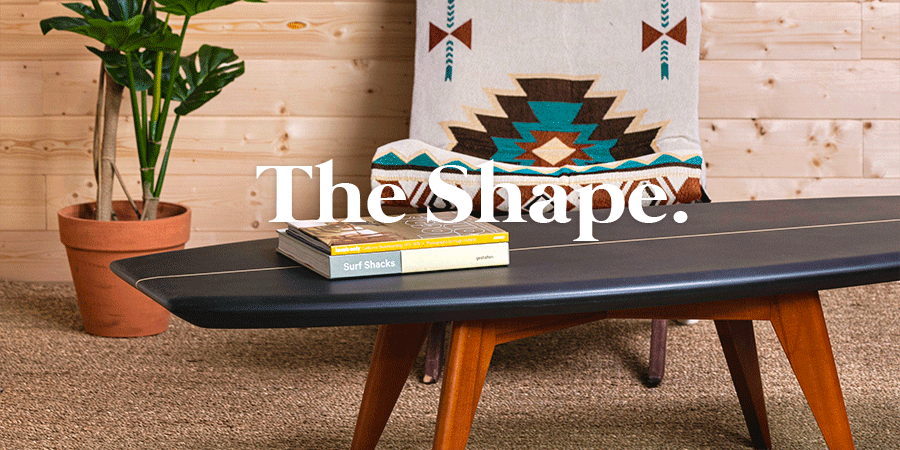How are surfboard coffee tables made ?
If you want to learn more about our products, you are in the right place! Discover the different steps of manufacturing our surfboard coffee tables. Passionate about surfing and swayed by the sound of the waves since our childhood, we wanted to use shaper's techniques to make our products and bring back this coastal spirit in the heart of our homes.
Step 1 of your Surfboard coffee table: The Blank
What is a blank?
A surfboard is made from a blank, which forms the core of the board. It is often made of polyurethane (PU, hard foam) and has the approximate shape of a surfboard. It can be recognised by its wooden plate of about 6mm which crosses it in length. Called stringer, this allows to glue the two halves between them and thus reinforces the foam bar, reducing the risk of the board twisting or snapping.
It is important to pay attention to the properties of the wood that composes the stringer because they will influence the flexibility or not of the board. The density is also different depending on the foam block chosen, so it is important to select the best weight - strength ratio.
Step 2 of your Surfboard coffee table: The Shape
The core of the surfboard coffee table
Your surfboard blank is designed and shaped by hand using a variety of tools to give the board all its properties and curves. This is the most important part of the shaper's work, where you can express your creativity and test new shapes.
First a saw is used to cut the desired outline and then an electric plane is used to take off the hard outer skin of the blank and any large areas of foam that need to be removed.
The shaping work may or may not be easier depending on the foam bar chosen. With a softer foam bar, more material will be removed with each pass of the planer.
A rasping tool (surform) and then sandpaper are used to fine tune the blank and give the custom surfboard coffee table its finished shape. The sleek and elegant style of our boards comes from their lines directly inspired by 'Malibu' surfboards.
Your table may now be to laminating.
Step 3 of your Surfboard coffee table: The Lamination
The art of glassing
In the laminating process the surfboard is covered with woven fibreglass cloth. For your Surfboard coffee table we have 2 layers of 6 oz weight cloth on the bottom and 1 layer on the deck. The cloth is then saturated with Epoxy resin. Modern epoxy resins have better mechanical performance than polyester resin and they can also be treated with UV protection, which limits the yellowing of the boards over time.
After this sets and the insert have been attached a coat of sanding resin is applied and when this has hardened it is sanded down to give the final shape. A further coating of resin (the gloss coat) may be given which can then be polished to a high gloss finish.
Step 4 of your Surfboard coffee table: Drying
Be patient
We looked at the lamination process last time, which makes your board stronger and smoother. Before we move on to the painting stage, we need to go through the drying process. This is probably the least exciting part of the design process, but it is essential.
Step 5 of your Surfboard coffee table: Painting
Reveal the artist in you
Now that the resin is dry it is time to paint. To do this, we use our spray guns: a satisfying step but it requires a lot of skill and precision. It is necessary to protect the surfaces that will not be painted, and to clean the board well before painting to avoid traces of dust.
Step 6 of your Surfboard coffee table: Drying
Drying is really necessary
Once again we have to wait for the boards to dry. It is very important that the drying time is long enough, otherwise the paint may fall apart when we polish the boards.
Step 7 of your Surfboard coffee table: Polish
To get a perfect result
We Put a polishing pad onto the polisher in order to Polish the surface until it is clear and dry. The board should shine with a glossy finish or mat.
Step 8 of your Surfboard coffee table: The Legs
In order to have a table
That's it, we can say that the board is finished! Now to turn it into a real table, we have to add the legs. Our legs are made by a small wood factory that takes care of cutting and varnishing the wood.
Step 9 of your Surfboard coffee table: Packing
The final stage
That's it, the production stage is over, your surfboard coffee table has just been packed and is ready to be shipped to our beach theme home.
We would be delighted to see our tables in your homes,
send us pictures on Instagram with the #saltyhome!
Frequently Asked Questions (FAQs):
Q.1 How are surfboards used as furniture pieces ?
A. Surfboard tops are used as coffee tables and bookshelves after refurbishing them, Old or broken surfboards are painted, polished or decorated to make a new furniture piece out of it. Buy this Salty Home's surfboard shaped furniture for your home.
Q.2 What makes kai lenny’s salty collection different from others ?
A. Through SALTY, kai lenny wants to harness the ocean's energy and translate it into pieces of furniture that can connect with when not in the water. kai lenny’s collection really helps bring that sense of surf culture indoors. Using Surfboards as furniture pieces is an innovation in the coffee table trend.









